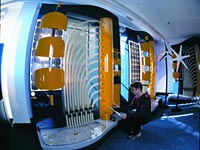|
||||||||||||||||||||||||||||||||||||||||||||
| Photovoltaics and Solar Energy | ||||||||||||||||||||||||||||||||||||||||||||

Photovoltaic devices, otherwise known as solar cells, are devices that convert sunlight directly into electricity and are capable of powering essentially any electrical load. Photovoltaic Engineering is concerned with the production and use of solar cells and the design and implementation of photovoltaic systems.
Solar energy is a major renewable energy resource which may be harnessed and used in many ways. UNSW has been a world leader in silicon solar cell research for approximately 15 years, and developed the most successfully commercialised photovoltaic technology throughout the same period. Photovoltaic Engineering covers a broad range of engineering tasks and disciplines but it can be summarised into 5 main areas:
Worldwide, the Photovoltaics industry is growing at approximately 30% each year. Recent studies, publications and media releases indicate that large numbers of jobs are being created in all aspects of photovoltaic and renewable energy engineering. Job opportunities exist in PV system design and implementation for remote areas, manufacturing, , quality control, grid-connected systems, fault diagnosis and testing, maintenance, simulation and modelling, technology development, marketing, financing, policy, education, project management, etc.
Studying Photovoltaics and Solar Energy At UNSW The study of Photovoltaics & Solar Energy is primarily though the School of Photovoltaic and Renewable Energy Engineering (www.pv.unsw.edu.au). Please refer to the table below. Postgraduate study is also available.
Photovoltaics and Solar Energy can be studied in the following Programs
Renewable Energy Engineering can be studied in the following Programs
|
||||||||||||||||||||||||||||||||||||||||||||



